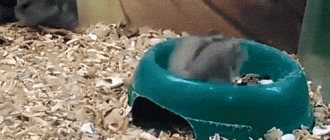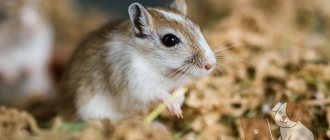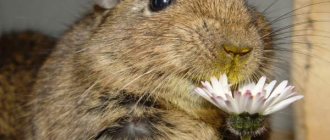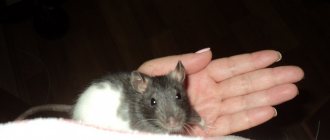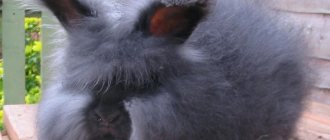- home
- Kinds
19.03.2018
The hamster is a very popular pet. Due to its compactness, it can be installed in an apartment of any size. There are about 20 species in nature. The most suitable for breeding at home are the Djungarian, Siberian and Campbell's hamsters. Breeders are attracted by the low price for the animal and easy care. Let's take a closer look at Siberian hamsters and everything about them.
Appearance
In appearance, the Siberian hamster resembles a fluffy ball with an inconspicuous tail. It reaches a length of 7-10 cm. The average weight of the animal is 25 g; if kept at home, it can increase to 50 g.
The main color of the hamster is black and gray with a brown longitudinal stripe on the back and a light gray belly. In addition to the usual coloring, sapphire and pearl colors have been bred. On the head are dark, almost black eyes and small ears. The presence of cheek pouches serves to collect and carry food. The short limbs of the paws with five toes are covered with hair.
How to feed?
The easiest way to feed is to use ready-made food, sold in any pet store. They contain a mixture of seeds and grains necessary for proper nutrition of a hamster. Usually one package lasts for a month.
Fruits and vegetables are periodically given as treats. But there should not be too many of them, otherwise the animal may have a bloated belly due to excess carbohydrates. A child will need from 10 to 20 g of “green stuff” per day.
After the next feeding, all leftover food is removed so that it does not spoil and subsequently cause poisoning. Although it is unlikely that scraps will be found in the feeder. The fact is that kids love to stock up “for the winter” by dragging grain in their cheek pouches and hiding them in different corners of the cage. Therefore, the bins are checked and cleaned periodically.
Hamsters usually drink little, since a sufficient amount of liquid comes from succulent food. Despite this, water must be constantly available and changed at least twice a day.
The Siberian is a very cute dwarf animal that will bring joyful bustle and variety into the life of any person.
Characteristics
Most rodent lovers want to know everything about Siberian hamsters. The presence of features in behavior and characteristics is expressed by the following criteria:
- Siberian hamsters are called white Russian dwarf hamsters because of the special property of changing the color of their coat: from gray to white in winter;
- adults lead a calm and slow lifestyle in relation to the young;
- Siberian hamsters are mainly nocturnal. With the onset of darkness, which serves as protection for them from encounters with insidious predators - foxes and owls, they go out in search of food.;
- orientation in space with the help of whiskers allows animals to determine the width of loopholes and the distance between objects;
- rodents easily recognize each other by the smell of the marked territory;
- different-sex individuals of the breed live together only during the mating season, and the rest of the time they live separately and protect their homes from encroachment by other animals;
- with the onset of three months of age, females are able to reproduce with a gestation period of 19 days.
Diet
In order for your pet to grow up healthy, it is important to provide it with proper nutrition. You need to feed him regularly, twice a day - morning and evening.
Did you know? Dill, plantain and dandelion are a real treat for the animal.
What is possible
The animal's diet must contain grain and granulated mixtures. But you shouldn’t limit yourself only to store-bought food. Include in the menu:
- fruits (including dried);
- vegetables;
- greenery;
- boiled chicken meat;
- egg;
- cottage cheese;
- strawberries;
- raspberries;
- grape.
What not to do
You should not give human food to rodents. It is prohibited to include in the diet:
- fried, salty foods;
- sweet, sour, flour and spicy dishes;
- garlic; beets;
- cabbage;
- onion;
- plum;
- citrus.
Before you get a hamster, find out what to feed it. We recommend reading about what diet is most suitable for hamsters.
The Siberian hamster is a wonderful animal that will bring you and your child a lot of pleasure. However, we should not forget that, like any living creature, rodents need proper care and attention. Their absence can significantly reduce the life expectancy of a fluffy.
Natural living environment
In the wild, Siberian hamsters live on hilly and flat steppes. They live alone and in small groups. The established community does not accept adult newcomers. The animals' home is burrows, which they themselves dig in the form of tunnels to a depth of 1.5 meters. A labyrinth of numerous passages provides space for nesting and food storage and reaches a length of up to 8 meters.
Males occupy up to 12 hectares of housing area. The territorial qualities of the hamster's character make it possible to carefully protect the home from uninvited guests. Females settle nearby and are under the care of the stronger sex. Their territory is smaller than that of the male. In winter, rodents have to go into prolonged torpor to survive severe frosts. This process cannot be called full hibernation, because animals have to wake up periodically to consume food.
Siberian hamster at home
The Siberian hamster at home is an unpretentious animal. It can live in a cage and will comfortably set up its burrow in an aquarium. It is unpretentious in nutrition and does not require strict air temperature for maintenance. In comfortable conditions they live up to 4 years, with proper care and maintenance. The age of the hamster does not affect mobility; an “elderly” rodent is as active as a young one.
Features of keeping and caring for a hamster
A hamster, like any other pet, needs proper care. How to care for hamsters? The cage for it should be:
- Spacious so that he can move comfortably, you can arrange a second floor, he will be happy to explore the space. If the cage is not very large, put a running wheel in it. Without movement, the hamster quickly gets fat and gets sick.
- The gaps between the bars of the cage should be no more than 8 mm, otherwise the furry pet will definitely try to escape.
- Easy to clean. The bedding in the cage needs to be changed every 1-2 days, so it is important that this can be done easily and conveniently. Aspen sawdust or white paper are best suited for bedding; paper with dyes should not be used, as the paint composition is harmful to the animal.
You can place the rodent in an aquarium of suitable size, so it will not have a chance to escape. But cleaning an aquarium is more difficult than cleaning a cage.
During cleaning, the pet should be placed in a container or allowed to run around the house in a special wheel (one of the household should monitor the animal during this time). Hamsters do not like encroachments on their territory, so they can be aggressive if you start cleaning in their presence.
The location for the cage is chosen away from heat devices and direct sunlight (bright light irritates blind eyes); direct proximity to household appliances is undesirable, since rodents are sensitive to sharp sounds and detect ultrasound. Such content will be the most comfortable for the pet.
If you plan to raise offspring, you can keep two hamsters in one cage at once, but introduce them to each other as early as possible, preferably from childhood. They may need two houses as they like privacy. Hamsters reproduce quickly. If you do not need numerous offspring, then it is better to keep rodents in adjacent cages or in a cage with a partition.
Fictional breeds
There are about 20 varieties of hamsters on the planet, but sometimes groups of hamsters with certain characteristics are mistakenly classified as separate non-existent breeds. Such fictitious breeds will be discussed in this section.
Albino
Albinos are hamsters whose bodies do not produce the hormone melanin. As a result, they have white fur and red eyes, with blood vessels visible through the colorless iris. They have increased sensitivity to light. Such hamsters are not classified as a separate breed, because this is only a malfunction of the genetic apparatus of a Syrian, Djungarian or any other breed of hamster.
Angora
This is an artificially bred long-haired Syrian hamster. It got its name because of its shaggy coat, which looks like the fur of an Angora goat. Distinctive features are the absence of a tail, small front legs, large cheeks and long hair, which in males reaches 5 cm. The color can be different: spotted, cream, white, black.
Royal
The shaggy golden Syrian hamster is passed off as a royal hamster. But there is no such breed; usually this is done to obtain the greatest benefit.
Black
A black hamster can be a Syrian, Djungarian, or Chinese hamster, because it is not a separate breed, but simply a fur color. Black hamsters are considered animals that do not have any spots of a different color on their body. It is acceptable to have white color on the toes and paws. They are very difficult to breed, which is why they are expensive.
Golden
There is no breed of golden hamster. This is sometimes the name given to Syrian hamsters, whose skin color has a bright golden-sandy hue.
White
White hamsters are usually albinos. They are often passed off as a separate rare species by pet store sellers to make more profit.
Behavior and instincts
Hamsters are nocturnal inhabitants. During the day they are forced to hide from predators. This behavioral feature in the wild persists even when kept at home. At night, the pet can make noise, run in a wheel, rustle with sawdust. This mode must be taken into account when choosing a location for the cage.
The hamster loves to arrange his own house. If you notice that he drags a lot of sawdust there and covers the burrow with it, it means he is cold. If the hole is empty and the sawdust has been moved away, he is hot.
The Siberian hamster is very clean; most of the time he washes himself and combs his fur. This process looks very funny. If the animal has stopped cleaning itself, this is an alarming sign and may indicate a disease. It is worth taking your pet to the veterinarian.
If the rodent freezes or quietly creeps towards the house, most likely some noise scared him. Do not disturb the animal, it will calm down on its own and will be cheerful and playful again. When he is in a good mood, he runs in the wheel for a long time. If you see him standing on his hind legs, he is very interested in something.
But if the hamster growls and bares his teeth, it is better not to touch him. Although this behavior is rare, these animals are very good-natured, love children and are not offended.
Where to place it?
Before you bring a hamster into your home, you need to prepare a place for it to live. If you don't take this seriously, the baby will get lost in a large apartment and die.
Hamsters are not very demanding of the external environment, but feel good at a comfortable temperature of 17 to 26 degrees Celsius.
Everything that is unpleasant for us will not be pleasant for the hamster either. When assigning a cage to a particular place, you should think about whether it will be comfortable for him to be there. Considering the negative impact of some places in the house, we can conclude that you should not install a cage:
- near the radiator;
- on the windowsill, in direct sunlight;
- near operating equipment;
- in a draft;
- in noisy places;
- in bedrooms (taking into account the nocturnal lifestyle of pets).
Article on the topic: Radde's hamster (Pre-Caucasian, Dagestan): description and photo
